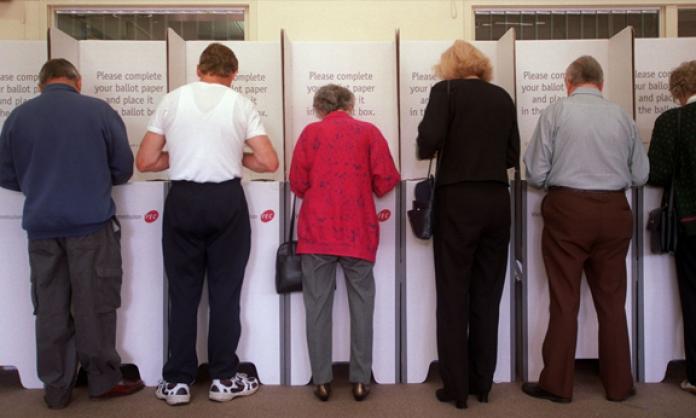In an age when governments are lucky to inspire anything other than contempt among the mass of people, the Victorian Labor government gained a significant swing in the 24 November election. The ALP will likely increase its lower house majority from 45 seats to more than 55 (of 88) and is on track to take 18 of the 40 seats in the Legislative Council.
The hard law and order campaign run by the opposition Liberals, which involved whipping up panic about crime, vilifying immigrants and promising an array of measures to ensure more people spend longer in jail, failed disastrously.
In the south- and outer-eastern suburbs, where there is a disproportionate number of marginal seats, the Liberals distributed material depicting shadowy figures in hoodies (read immigrant youth) declaring “Only the Liberals will stop gangs hunting in packs”. Billboards in the area featured the slogan “Make Victoria Safe Again”.
“Jail the gangs” placards were brandished by supporters at Liberal events throughout the campaign. And party leaders attempted to capitalise on the Bourke Street attack by vilifying Muslims and ostentatiously visiting Pellegrini’s Espresso Bar after the murder of popular proprietor Sisto Malaspina. The federal party assisted by focussing on the right wing talking point of immigration a few days out from the poll.
The Liberals also enjoyed vigorous support from Murdoch’s Herald Sun, which has been unrelenting in its coverage of the supposed crime wave sweeping Victoria, as it has in amplifying every Liberal line of attack against Labor over the last four years.
That this campaign failed so spectacularly is very positive. It shows that it is not ordinary people driving the lurch to the right in official politics, but a political class with nothing else to offer. When given the choice, large numbers of people favour even limited social democratic reform over Trump-inspired authoritarianism. Scapegoating, terrorism hype and law and order tub thumping – the stock in trade of conservative politicians – only works in the absence of anything better.
But other factors also worked against the Liberals. That crime in Victoria is at historic lows, relative to the total population, meant there was not a huge amount of pre-existing concern for politicians to tap into. Most people’s daily experience doesn’t fit with the image promoted by the Liberals, even if it succeeded in scaring some people.
Added to that, the Andrews government has determinedly one-upped its opponents in the law and order bidding war, cutting some of the ground from under the Liberals’ feet. Labor has spent a huge amount on the police, equipping them with high-tech weaponry and increasing their numbers to unprecedented levels. Andrews also made draconian changes to bail, sentencing and parole laws, expanded the prison system and took a hard stand over the detention of children in adult prisons.
Nor was the premier outdone by the Liberals after the Bourke Street attack. Andrews endorsed Scott Morrison’s comments that “the greatest threat to our way of life is radical, violent, extremist Islam”, effusing that the prime minister had “struck the right balance”.
Indeed, the Andrews government combines a few high profile reforms (a handful of level crossing removals and some big road and rail projects) and gestures towards social justice (establishing a Pride Centre, negotiating a treaty with Indigenous people and addressing family violence) with a more low key but just as hardline commitment to ensuring its tough-on-crime credentials are second to none.
Adding to the Liberals’ problems in Victoria is the unpopularity of the federal government and the influence the loony right wields within it. The widening rift between wealthy, right wing but socially liberal voters in the party’s traditional blue ribbon heartlands (who identified with the now deposed Turnbull) and those in outer suburban and regional areas being drawn toward One Nation and more extreme right political groupings (and well-disposed towards ex-cop Peter Dutton and the Abbott circus) was on full show.
Hot on the heels of the party’s Wentworth defeat, the Liberals came perilously close to losing Brighton, a seat conservatives have always held, and will likely lose Hawthorn and Caulfield, electorates that have never in the case of Caulfield or only once in the case of Hawthorn, been won by Labor.
The premier party of the Australian bourgeoisie, one of the most successful political parties in the world, is thus wracked by an internal crisis that it cannot easily emerge from.
Torn between the traditional moderates who, as Turnbull demonstrated, have limited capacity to win support outside of corporate boardrooms, and a belligerent right wing with an agenda disconnected from the key concerns of the class it is supposed to represent, the party is facing a federal electoral disaster following the Victorian rout.
It has proven incapable of providing the stable, low tax, pro-business environment the bosses want. Successive Liberal governments have been unpopular, unable to control the parliament or obsessed with niche issues like Safe Schools or religious freedom.
All this is good news for the ALP at state and federal levels, but a mixed blessing for Labor’s working class supporters. A Labor government that coasts to victory on the back of Liberal disarray and with the assent of big business will not be under pressure to deliver significant reforms to the union movement and the working class.
Particularly in Victoria, where ensuring the election of Labor governments has become the primary focus of the union movement (but without clear conditions or demands on the party), this can end up contributing to greater cynicism among workers and further undermining rank and file union strength.
The 1.2 percent swing away from the Greens in Victoria – which looks likely to reduce the party’s representation in the Victorian parliament from eight to just three or four – is another factor working in Labor’s favour. It was a bad election for the Greens. But given the relatively popular, social democratic-style Labor government with a strong swing toward it, and a number of scandals about Green candidates and staffers, the result could have been a lot worse.
Yet the broader context also matters. The Greens have for some time now failed to connect with social layers beyond those in which they are already firmly entrenched: inner city professionals with a social conscience. Their policies and approach do not by and large appeal to the mass of blue-collar workers, and nor does the party try to build support within the unions.
The Greens are thus incapable of seriously challenging Labor from the left. At best, they may steal a handful of seats from them and the Liberals. What is needed, and what the success of Victorian Socialists shows there is space to build, is a class based alternative to the neoliberal consensus that has characterised the two major parties for decades.
Daniel Andrews declared on election night that his was “the most progressive government in the country”. While this may be accurate, it should be kept in perspective. The infrastructure projects are modest and long overdue. The government has not reversed privatisation but extended it, leasing the Port of Melbourne, extending public transport contracts to private companies and moving to sell public housing land.
When Scott Morrison told school kids planning to strike against climate change to stay in school, Andrews did not encourage them or give them the day off.
And while Andrews celebrated the election result as a rejection of “the low road of fear and division”, his government has expanded the prison system and trampled over civil liberties in the name of “fighting terrorism” and “combating gangs” well beyond what the previous Liberal government dared.
Since the election, he has created a minister for crime prevention – a Liberal Party promise during the election – to assuage any doubt about the government’s commitment to law and order.
The electoral success of the Labor government shows just how low expectations have sunk when it comes to governments spending money on initiatives people want and need.
Nevertheless, there is a lot to take heart from in the Victorian election. Even the limited reform agenda offered by Labor was enough to defeat the right wing law and order panic and scapegoating of immigrants served up by the Liberals.
Measures that address bread and butter issues – well funded healthcare, schools and reliable transport – that survey after survey find matter more to people than the threat of terrorism or longer jail terms, can undercut the agenda of the right wing.
Victoria is not a world apart from the rest of the country, even if the Liberals wish it were. If the right can be defeated so resoundingly here, it can be everywhere.









